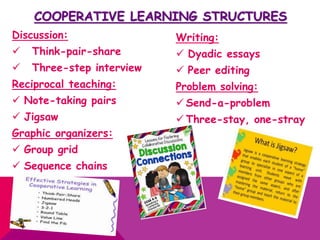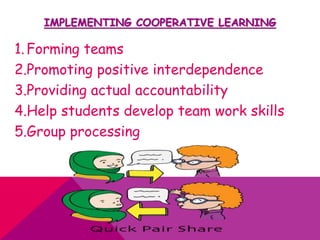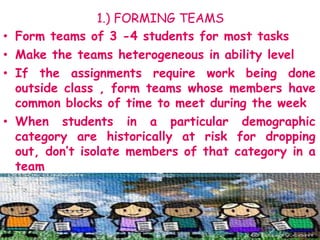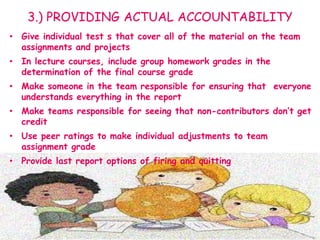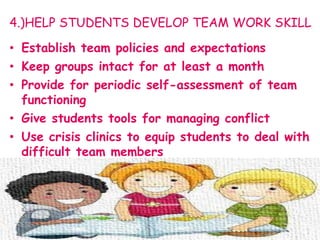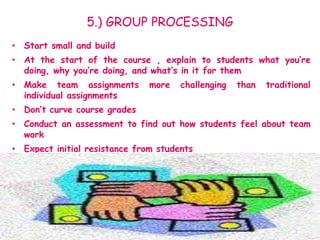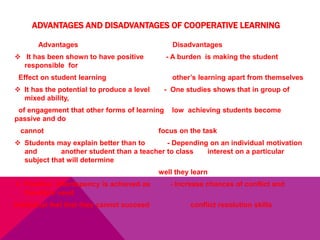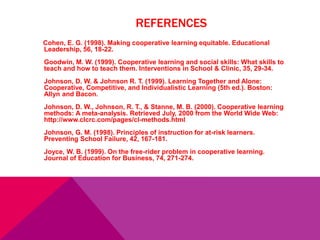COOPERATIVE LEARNING STRATEGY
- 1. PREPARED BY: MARYJO R. LIBOON
- 2. A teaching strategy where small teams of students (or adults), with differing abilities, work together, using a variety of learning activities to improve their understanding of a subject. Students use and develop a variety of personal skills ( communication, listening, collaboration) to accomplish a shared learning goal set by the teacher/facilitator. (Jhonson and Jhonson 1999, Sutherland and Wehby 2000, Sharan 2010)
- 3. WHERE DOES “CL” COME FROM? Philosopher John Dewey believed in “ Progressive education”. He wanted to ensure students would grow up to be active and responsible democratic citizens. Social Psychologist Morton Deustsch believed cooperation established interpersonal trust and built stable relationships. In the 1960’s and 1970s CL research and practice expanded around the world as a way to decrease conflict among the cultural differences in schools. (Sharan, 2010)
- 4. COOPERATIVE LEARNING STRUCTURES Discussion: Think-pair-share Three-step interview Reciprocal teaching: Note-taking pairs Jigsaw Graphic organizers: Group grid Sequence chains Writing: Dyadic essays Peer editing Problem solving: Send-a-problem Three-stay, one-stray
- 5. IMPLEMENTING COOPERATIVE LEARNING 1.Forming teams 2.Promoting positive interdependence 3.Providing actual accountability 4.Help students develop team work skills 5.Group processing
- 6. 1.) FORMING TEAMS • Form teams of 3 -4 students for most tasks • Make the teams heterogeneous in ability level • If the assignments require work being done outside class , form teams whose members have common blocks of time to meet during the week • When students in a particular demographic category are historically at risk for dropping out, don’t isolate members of that category in a team
- 7. 2.) PROMOTING POSITIVE INTERDEPENDENCE • Assign different roles to team members • Use jigsaw to set up specialized expertise within each team • Give a bonus on test • Team member should report on each part of the subject
- 8. 3.) PROVIDING ACTUAL ACCOUNTABILITY • Give individual test s that cover all of the material on the team assignments and projects • In lecture courses, include group homework grades in the determination of the final course grade • Make someone in the team responsible for ensuring that everyone understands everything in the report • Make teams responsible for seeing that non-contributors don’t get credit • Use peer ratings to make individual adjustments to team assignment grade • Provide last report options of firing and quitting
- 9. 4.)HELP STUDENTS DEVELOP TEAM WORK SKILL • Establish team policies and expectations • Keep groups intact for at least a month • Provide for periodic self-assessment of team functioning • Give students tools for managing conflict • Use crisis clinics to equip students to deal with difficult team members
- 10. 5.) GROUP PROCESSING • Start small and build • At the start of the course , explain to students what you’re doing, why you’re doing, and what’s in it for them • Make team assignments more challenging than traditional individual assignments • Don’t curve course grades • Conduct an assessment to find out how students feel about team work • Expect initial resistance from students
- 11. ADVANTAGES AND DISADVANTAGES OF COOPERATIVE LEARNING Advantages Disadvantages It has been shown to have positive - A burden is making the student responsible for Effect on student learning other’s learning apart from themselves It has the potential to produce a level - One studies shows that in group of mixed ability, of engagement that other forms of learning low achieving students become passive and do cannot focus on the task Students may explain better than to - Depending on an individual motivation and another student than a teacher to class interest on a particular subject that will determine well they learn Positive interdepency is achieved as - Increase chances of conflict and therefore need Individual feel that they cannot succeed conflict resolution skills
- 12. Unless everyone in their group succeed. Interpersonal and collaboration skills - It is very difficult for teacher to be can be learned in cooperative learning sure that the group are discussing Activity. academic content rather than something else. Higher ability students are in position - Lower ability students may feel to be experts, leaders, models, and teachers; perpetually in need of help rather than lower ability students get the benefits of having experiencing the role of leader or expert higher ability in their group. relative to the others in their group.
- 13. REFERENCES Cohen, E. G. (1998). Making cooperative learning equitable. Educational Leadership, 56, 18-22. Goodwin, M. W. (1999). Cooperative learning and social skills: What skills to teach and how to teach them. Interventions in School & Clinic, 35, 29-34. Johnson, D. W. & Johnson R. T. (1999). Learning Together and Alone: Cooperative, Competitive, and Individualistic Learning (5th ed.). Boston: Allyn and Bacon. Johnson, D. W., Johnson, R. T., & Stanne, M. B. (2000). Cooperative learning methods: A meta-analysis. Retrieved July, 2000 from the World Wide Web: http://www.clcrc.com/pages/cl-methods.html Johnson, G. M. (1998). Principles of instruction for at-risk learners. Preventing School Failure, 42, 167-181. Joyce, W. B. (1999). On the free-rider problem in cooperative learning. Journal of Education for Business, 74, 271-274.
- 14. - E N D - H A N K Y O U T H A N K Y O U



